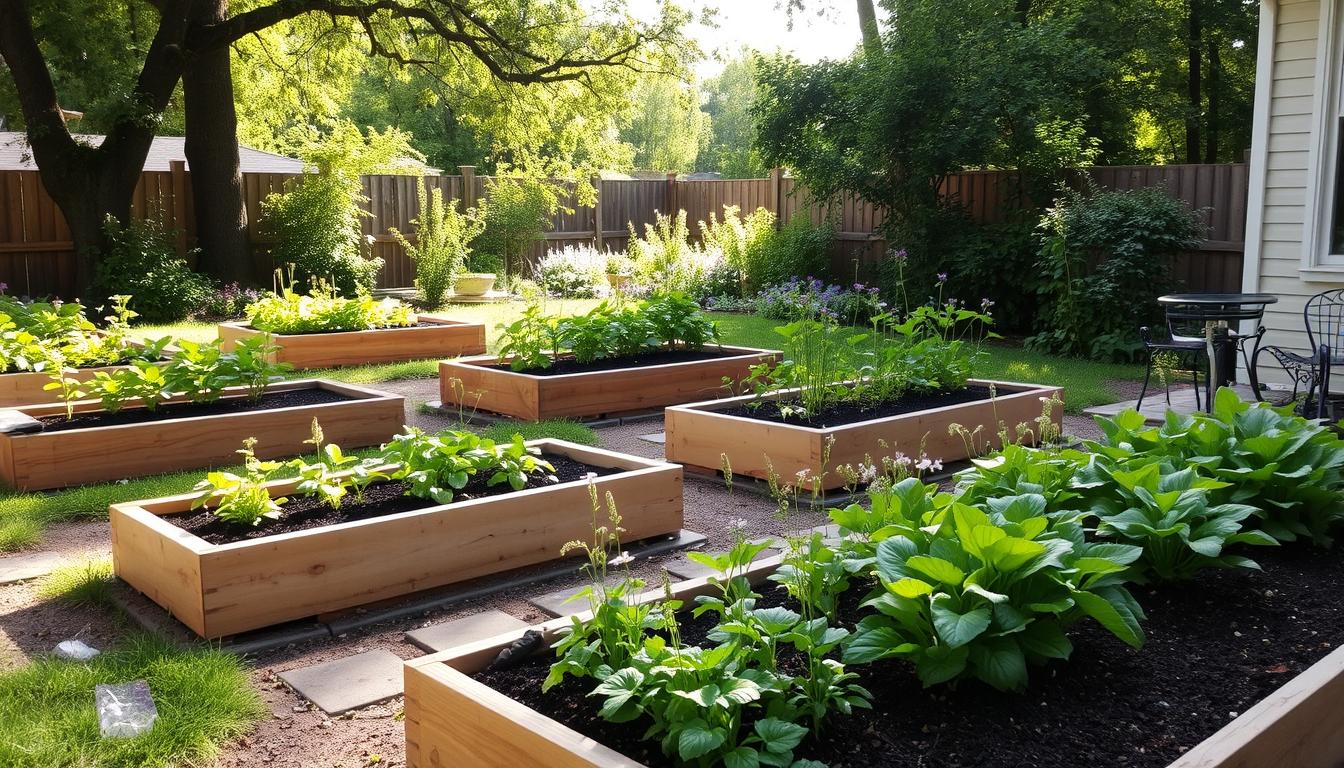Transforming your outdoor space into a vibrant oasis is easier than you think. Raised beds offer a practical and stylish solution for yards of all sizes. Whether you’re in a bustling city or a quiet rural area, these structures can elevate your space with minimal effort.
From colorful flowers to fresh vegetables and aromatic herbs, raised beds provide the perfect environment for a variety of plants. They not only enhance the aesthetics of your yard but also improve functionality by optimizing soil quality and drainage.
Popular materials like cedar and galvanized steel ensure durability and a polished look. Many homeowners, including clients of Rooted Garden, have successfully transformed their spaces using these versatile solutions. Discover how you can create a stunning and functional yard today.
Key Takeaways
- Raised beds are ideal for yards of all sizes, urban or rural.
- They support a variety of plants, including flowers, vegetables, and herbs.
- Improved soil quality and drainage are key benefits.
- Durable materials like cedar and galvanized steel are popular choices.
- Real-life success stories highlight their transformative potential.
Introduction to Backyard Garden Boxes
Discover how framed planting areas can transform your yard effortlessly. These structures, often called raised garden beds, are elevated plots designed to enhance soil quality and drainage. They’re perfect for creating a contained growing environment above ground level.
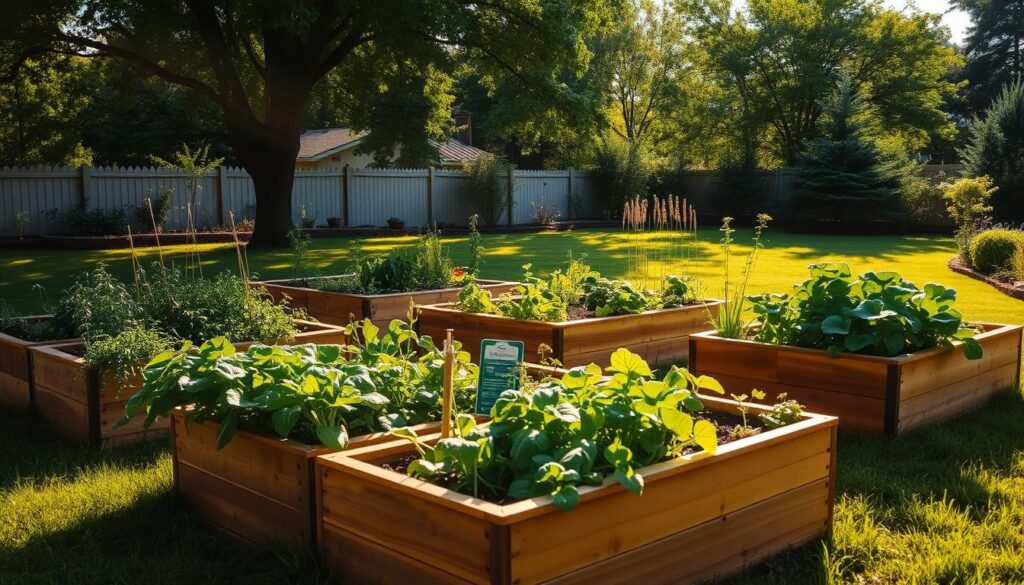
What Are Backyard Garden Boxes?
Raised garden beds are framed planting areas that sit above the ground. They’re typically made from materials like cedar or galvanized steel and come in popular sizes such as 3x6ft or 4x8ft. These beds allow you to control the soil, ensuring optimal conditions for your plants.
Unlike traditional in-ground gardening, raised beds offer a contained space that’s easier to manage. They’re ideal for areas with poor native soil or limited mobility. With these beds, you can grow flowers, vegetables, and herbs without the hassle of tilling or weeding large areas.
Why Choose Backyard Garden Boxes for Your Yard?
There are several reasons to opt for raised beds. First, they warm up faster in the spring, giving your plants a head start. Second, they provide better pest control by keeping critters at bay. Finally, they optimize space, making them perfect for small or oddly shaped yards.
“Raised beds have completely changed the way I garden,” says a satisfied Rooted Garden client. “They’re easy to maintain, and my plants thrive like never before.”
Whether you’re dealing with compacted soil or looking for a more ergonomic gardening solution, raised beds are a game-changer. They’re not just functional—they’re a stylish addition to any outdoor space.
Benefits of Using Backyard Garden Boxes
Elevate your outdoor experience with the practical benefits of raised bed gardening. These structures offer a range of advantages that make planting easier, more efficient, and more enjoyable. From improved soil quality to reduced maintenance, raised beds are a game-changer for gardeners of all skill levels.
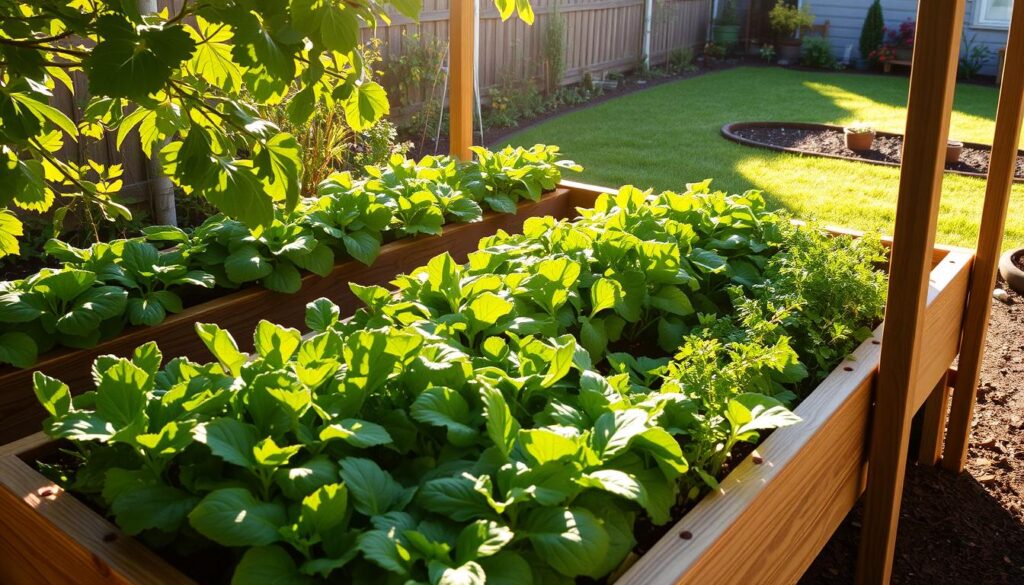
Improved Soil Quality and Drainage
One of the standout benefits of soil raised beds is their ability to enhance soil quality. Unlike traditional in-ground planting, raised beds allow you to control the soil composition. This ensures optimal conditions for plant growth. Additionally, elevated beds improve drainage, reducing waterlogging by up to 40% compared to ground planting.
Scientific studies show that raised setups provide 25% better root aeration. This leads to healthier plants and higher yields. Whether you’re growing flowers, vegetables, or herbs, improved soil quality is a key advantage.
Enhanced Accessibility and Ergonomics
Raised beds are designed with accessibility in mind. Their ideal height of 18-24 inches makes them perfect for back-friendly gardening. This feature is especially beneficial for older gardeners or those with mobility issues.
“I used to struggle with bending and kneeling, but raised beds have made gardening so much easier,” says a Rooted Garden client. The ergonomic design ensures that you can enjoy planting without strain or discomfort.
Reduced Weed Growth and Soil Compaction
Another significant benefit is the reduction in weed growth. Raised beds use controlled soil composition, which minimizes the chances of weeds taking over. This means less time spent weeding and more time enjoying your plants.
Soil compaction is also less of an issue with raised beds. The elevated structure prevents heavy foot traffic, keeping the soil loose and aerated. This creates a healthier environment for plant roots to thrive.
| Feature | Traditional Gardening | Raised Bed Gardening |
|---|---|---|
| Soil Quality | Limited control | Fully customizable |
| Drainage | Prone to waterlogging | 40% better drainage |
| Weed Growth | High | Reduced significantly |
| Accessibility | Requires bending/kneeling | Ergonomic design |
With proper construction, raised beds also require 30% less water, making them an eco-friendly choice. For more tips on creating a sustainable outdoor space, visit NewGen Living.
Types of Backyard Garden Boxes
Explore the different styles of raised planting solutions to suit your outdoor needs. From classic designs to compact options, there’s a variety of choices to match your space and preferences. Whether you’re working with a large yard or a small patio, these structures can elevate your planting experience.
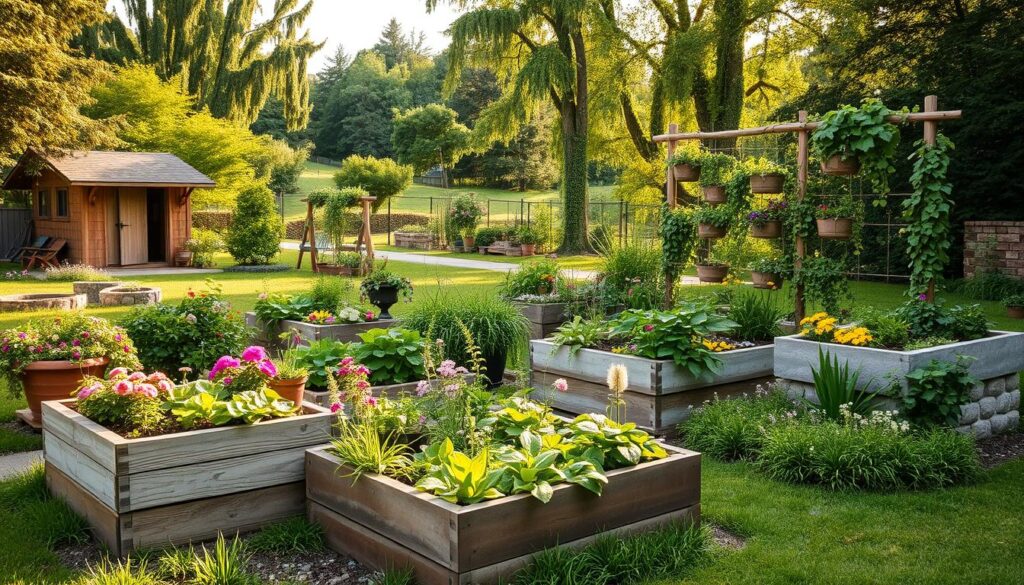
Classic Raised Garden Beds
Classic raised beds are a timeless choice for any outdoor space. Typically measuring 8 feet in length, these beds are ideal for larger areas. They provide ample room for growing a mix of flowers, vegetables, and herbs. Their height of 18-24 inches ensures easy access and reduces strain on your back.
Made from durable materials like cedar, these beds resist rot and pests naturally. Vermont-made cedar boxes, reinforced with aluminum corners, are a popular option. They’re built to last over 10 years, making them a long-term investment for your gardens.
Raised Bed Planters for Small Spaces
For urban settings or limited areas, compact planters are the perfect solution. These designs, often 4 feet in length, fit seamlessly on patios or decks. They use 2.5x less water than traditional plots, making them eco-friendly and efficient.
Vertical integration options, like arch trellises, maximize space. This allows you to grow climbing plants like beans or cucumbers. Small-space planters are a smart choice for anyone looking to optimize their outdoor area.
Cedar Raised Garden Beds
Cedar raised beds are a favorite among gardeners for their durability and aesthetic appeal. The natural oils in cedar make it resistant to rot and pests, ensuring longevity. These beds are available in various sizes, from 4 to 8 feet, to suit different needs.
Their elevated design improves soil quality and drainage, creating an ideal environment for plants. Whether you’re growing flowers or vegetables, cedar beds provide a sturdy and stylish foundation for your elevated garden.
| Feature | Classic Cedar Beds | Compact Planters |
|---|---|---|
| Size | 8 feet | 4 feet |
| Water Efficiency | Standard | 2.5x less water |
| Material | Cedar | Various |
| Best For | Large spaces | Patios/decks |
Choosing the Right Materials for Your Garden Boxes
Selecting the right materials for your planting structures can make all the difference in their longevity and performance. Whether you prioritize durability, aesthetics, or eco-friendliness, there’s a material to suit your needs. Let’s explore the top options available today.
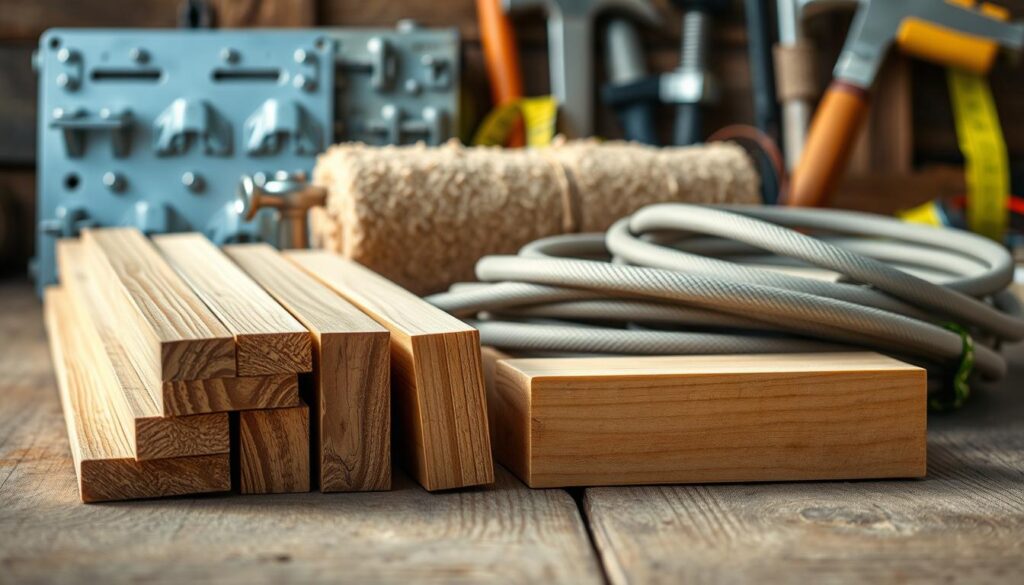
Wood: Cedar and Redwood
Wood is a classic choice for planting structures, offering natural beauty and insulation. Cedar and redwood are particularly popular due to their resistance to rot and pests. These materials blend seamlessly into outdoor spaces, providing a timeless look.
Cedar’s natural oils make it highly durable, often lasting over 10 years with minimal maintenance. Redwood, on the other hand, is known for its rich color and strength. Both options are ideal for those seeking a traditional yet functional design.
Metal: Galvanized Steel and Aluminum
For a modern aesthetic, metal options like galvanized steel and aluminum are excellent choices. Galvanized steel is incredibly durable, lasting 20+ years without rusting. It’s perfect for those who want a sleek, industrial look.
Aluminum, often used in hardware like Gardener’s Supply Company corner reinforcements, is lightweight and corrosion-resistant. Both materials require minimal upkeep, making them a practical choice for busy homeowners.
Composite and Recycled Plastic Options
If eco-friendliness is a priority, consider composite or recycled plastic materials. These options often blend wood fibers with recycled plastics, creating a durable and sustainable product. Many are made from 100% post-consumer materials, reducing environmental impact.
Recycled plastic beds, crafted from food-grade HDPE, are safe for growing edible plants. They’re also low-maintenance, requiring no staining or sealing. For those looking to combine sustainability with functionality, these materials are a standout choice.
| Feature | Wood | Metal | Plastic |
|---|---|---|---|
| Durability | 10+ years | 20+ years | 15+ years |
| Maintenance | Staining required | Powder-coated | None |
| Aesthetics | Natural | Modern | Versatile |
| Eco-Friendliness | Moderate | Low | High |
“Choosing the right material is essential for creating a long-lasting and beautiful planting space. It’s not just about looks—it’s about functionality and sustainability.”
Whether you prefer the natural charm of wood, the sleek appeal of metal, or the eco-friendly benefits of plastic, there’s a material to match your vision. For more tips on building durable outdoor structures, check out this guide.
Designing Your Yard with Backyard Garden Boxes
Crafting a functional and beautiful outdoor area starts with smart design choices. Whether you’re working with a large yard or a compact patio, thoughtful planning ensures your space thrives. From assessing your needs to incorporating vertical elements, every step matters.
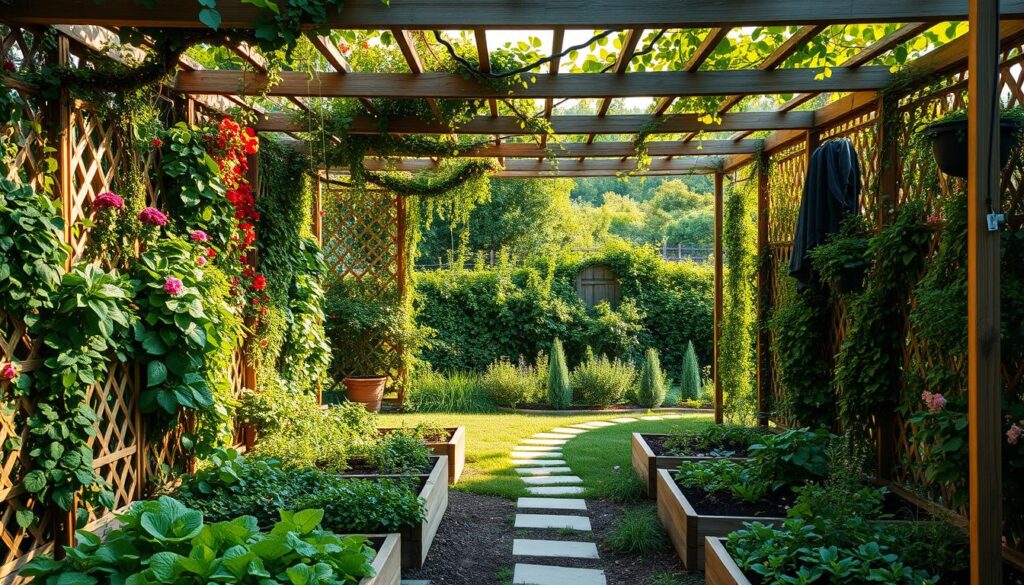
Assessing Your Space and Needs
Start by evaluating your outdoor area. Measure the space and note sunlight patterns. For every 100 square feet, consider adding one raised structure. This formula ensures balanced growth without overcrowding.
Sun mapping is a useful technique. Track sunlight throughout the day to determine the best spots for vegetables or flowers. This approach maximizes plant health and yield.
Planning the Layout for Optimal Growth
Once you’ve assessed your space, focus on the layout. Leave 12-18 inches between structures for easy access and airflow. This spacing prevents overcrowding and promotes healthy growth.
Self-watering inserts, like those from Gardener’s Supply, can simplify irrigation. These tools ensure consistent moisture levels, reducing the need for frequent watering.
Incorporating Trellises and Vertical Gardening
Vertical gardening is a game-changer for small spaces. Adding trellises allows you to grow climbing plants like cucumbers and beans. Studies show vertical setups can increase yields by up to 40%.
Companion planting is another smart strategy. Pairing compatible plants in a 6-bed rotational layout enhances growth and reduces pests. This method creates a balanced and thriving outdoor area.
“Vertical gardening not only saves space but also adds a unique aesthetic to your outdoor area. It’s a win-win for functionality and style.”
By focusing on smart garden designs, you can transform your ground into a lush and productive haven. Whether you’re a beginner or an experienced gardener, these tips ensure success.
Building and Installing Your Backyard Garden Boxes
Building and installing raised beds can transform your outdoor area with ease. Whether you’re a DIY enthusiast or a beginner, this guide will walk you through the process step-by-step. With the right tools and techniques, you’ll have a functional and stylish space in no time.

Step-by-Step Guide to Building Raised Beds
Start by gathering your tools: a drill, level, and galvanized screws. DIY kits often include cedar boards and aluminum corners, making assembly straightforward. Measure the height of your bed to ensure it’s comfortable for planting—typically 18-24 inches is ideal.
Assemble the frame by securing the corners with screws. Use a level to ensure the structure is even. For permanent installations, consider the frost line in your area to prevent shifting over time. With these steps, you can build raised beds in under two hours.
Tips for Proper Installation and Placement
When installing your beds, ensure there’s at least 30 inches of clearance around them for easy access. Choose a sunny spot with good drainage to maximize plant health. Use a level to confirm the ground is even before placing the frame.
For added stability, anchor the beds with stakes or brackets. This prevents movement during heavy rain or wind. Proper placement ensures your plants thrive and makes maintenance easier in the long run.
Adding Accessories for Functionality and Style
Enhance your raised beds with accessories like wheeled bases for mobility or trellises for vertical planting. Stain colors can add a personal touch, while self-watering inserts save time and effort. These additions not only improve functionality but also elevate the overall look of your space.
“Accessories like trellises and wheeled bases make gardening more efficient and enjoyable. They’re a simple way to add both style and practicality.”
Pro tip: Use the SHIP49 code for free shipping on materials. This way, you can save on costs while creating a beautiful and functional outdoor area. With these tips, you’re ready to build raised beds that enhance your space and simplify your gardening routine.
Maintaining Your Backyard Garden Boxes
Keeping your raised planting structures in top shape ensures long-term success and vibrant growth. Proper care involves managing soil, optimizing water usage, and adapting to seasonal changes. With a few simple steps, you can maintain a thriving and productive space.
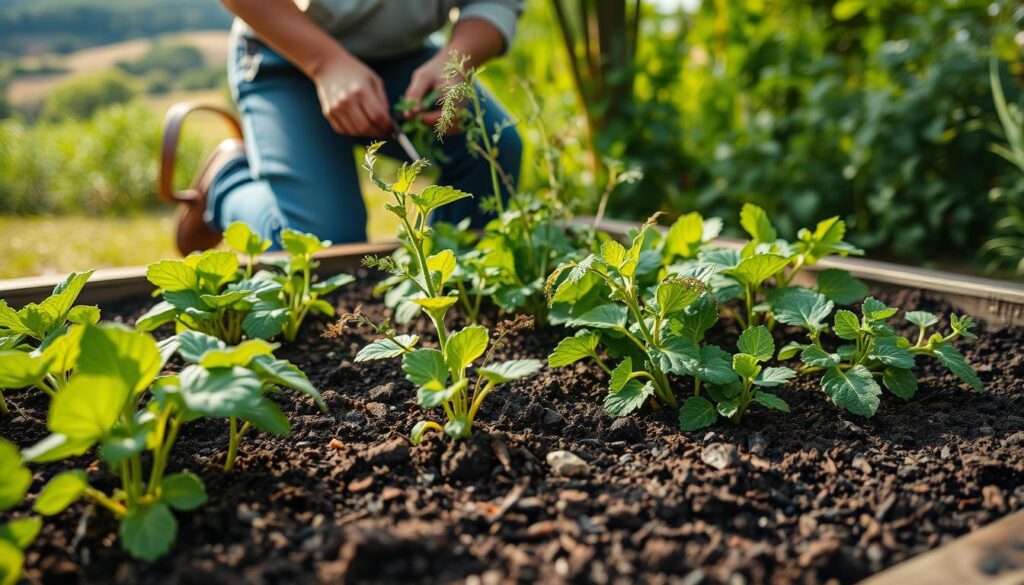
Soil Management and Fertilization
Healthy soil is the foundation of a successful planting area. Start by refreshing your bed every three years. Add layers of compost to replenish nutrients and improve texture. This process boosts yields by up to 35%.
Use a balanced fertilizer or a Gardener’s Supply booster kit to provide essential nutrients. These kits often include organic ingredients like bone meal and kelp, which promote strong root development and vibrant plants.
Watering and Irrigation Tips
Efficient water management is key to plant health. Drip irrigation systems deliver moisture directly to the roots, reducing waste. Soaker hoses are another great option, ensuring even distribution without overwatering.
Self-watering inserts can cut watering frequency by 60%. These tools maintain consistent moisture levels, making them ideal for busy gardeners. Always check the soil before watering to avoid over-saturation.
Seasonal Care and Plant Rotation
Seasonal changes require adjustments to keep your bed thriving. In winter, protect your structure by covering it with mulch or a tarp. This prevents frost damage and maintains soil quality.
Rotate crops annually to manage nitrogen levels and prevent pests. Use a rotation chart to plan which plants go where. For example, follow nitrogen-heavy crops like beans with lighter feeders like lettuce.
“Proper maintenance is the secret to a thriving planting area. It’s not just about growing—it’s about sustaining.”
By focusing on soil health, efficient water use, and seasonal care, you can ensure your raised planting structures remain productive and beautiful year after year.
Conclusion: Transform Your Yard with Backyard Garden Boxes
Creating a stunning outdoor space is simpler than you might imagine. Raised beds offer both beauty and functionality, making them a perfect choice for any yard. They improve soil quality, enhance drainage, and provide an ergonomic solution for all your gardening needs.
Now is the perfect time to take action. Use the limited-time SHIP49 offer to get started on your raised beds project. For those looking to deepen their knowledge, enrolling in the Kitchen Garden Academy can provide valuable insights and tips.
“Switching to raised beds has transformed my outdoor area,” says a satisfied Rooted Garden client. “It’s easier to maintain, and my plants are thriving like never before.”
Ready to begin your 30-day transformation? Start today and turn your yard into a vibrant, productive haven with raised beds.

